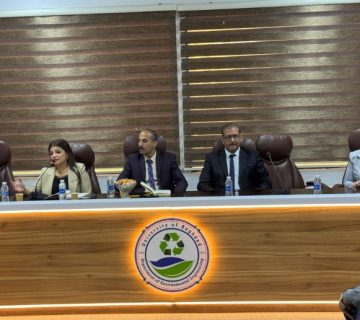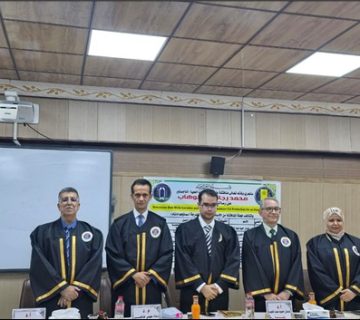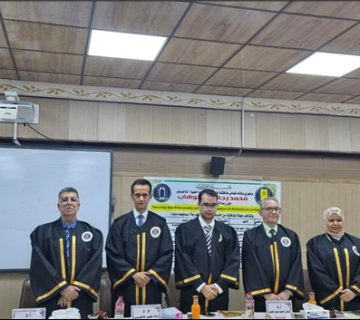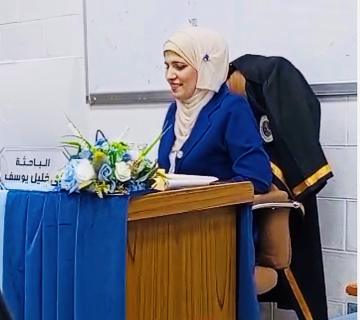Environmental Engineering Department at the College of Engineering, University of Baghdad, held PhD dissertation examination titled:
“Solar Heterogeneous Photocatalytic Degradation of Acetaminophen and Levofloxacien from Aqueous Solution: Batch and Continuous Modes”
By the student Alyaa Hussein Ali and supervised Prof.Dr.Abeer Ibrahim Musa on Monday 30/12/2024, in the Environmental Engineering discussion hall. The examination committee consisted of Prof.Dr. Ahmed Abd Mohammed as Chairman, and the membership of Prof.Dr.Firas Hashim Qamar, Prof.Dr. Muhanned Jasim Muhammed Ridha, Prof.Dr. Mohammed Sadiq Salman, and Assist.Prof.Dr.Hussein Jabar Kadhim. After conducting the public discussion and listening to the student’s defense, the dissertation was accepted. It was summarized as follows:
Pharmaceuticals wastes are of scientific and public concern recognized as classes of environmental pollutants and are receiving considerable attention with respect to their environmental fate and toxicological properties. Among the most widely consumed compounds among pharmaceutical drugs Acetaminophen (ACT) and Levofloxacien (LEVO) are considered toxic and dangerous chemical. For this, pharmaceutical pollutants waste need to be treated before being disposed into the environment. The current work presents to create a magnetically separable novel kind of nanocomposite known as Zeolite/Fe3O4/CuS/CuWO4 as an efficient photocatalyst for the degradation of (ACT) and (LEVO) residue from aqueous solutions in a solar–heterojunction photocatalysis reactor (batch and continuous mode). The obtained photocatalyst was characterized using various techniques such as XRD, FTIR, SEM, AFM, TEM, VSM, DRS, PL, BET, EDS mapping, and UV-vis spectroscopy. The influence of different variables pH from (3-11), pharmaceutical concentration of pollutants ranging from (10-50) mg/L, the concentration of the different forms of Zeolite/Fe3O4/CuS/CuWO4 ranging from (0.5-3) g/L and irradiation time ranging from (0-120) min for LEVO and from (0-180) min for ACT. The experimental results showed that the removal efficiencies were (95.76and 82.67) % for ACT and LEVO, respectively at the best conditions, pH of 6.8, 10 mg/L pharmaceuticals pollutants concentration, and concentration of catalyst 2 g/L. In addition, the results confirm that the kinetics of pharmaceuticals pollutants degradation followed the first-order model. The synthesized catalyst exhibited an effective degradation process of pharmaceuticals pollutants solution under sunlight. The investigation indicated that the photogenerated (h+) species were not the major active species responsible for photocatalysis, and the addition of AgNO3 as particular scavengers (for radicals), and (CH3)2CHOH (for OH• radicals) had a negative influence on the composite’s photocatalytic activity. Importantly, the synthesized nanocomposite demonstrated excellent reusability, with a photodegradation efficiency of 60.45% after the fifth cycle of LEVO degradation and 61.46% of ACT, as there was no significant loss in photocatalytic activity over repeated cycles. For continuous system, three operating variables were studied which were the initial concentration of pharmaceuticals pollutants, flow rate and irradiation intensity. The best flow rate was 5 ml/min at 10 mg/L pharmaceuticals concentration with a maximum removal efficiency of 84.77%, 73.26% after 220 and 200 min for ACT and LEVO respectively. For real Acetaminophen wastewater, the maximum removal was 62.57% obtained at 240 min, also the maximum COD removal achieved for treating real Acetaminophen wastewater was 51.38% for solar irradiation system. Finally, heterojunction solar photocatalysis treatment by synthesized Zeolite/Fe3O4/CuS/CuWO4 successfully show a positive influence in elimination of pharmaceuticals pollutants.
The recommendations of this dissertation:
- Studying the capability of photocatalysis process for treating the binary and ternary solutions of pharmaceutical pollutants using sunlight irradiation system.
- Studying the use of Zeolite/Fe3O4/CuS/CuWO4 synthesized to get rid of other contaminants from the environment such as heavy metals or phenols.
- Investigate the feasibility of substituting Fe3O4 with other ferrites such as CuFe2O4, NiFe2O4, and ZnFe2O4 due to their magnetic and optical properties.
- Zeolite can be substituted with other photoactive supporting structures that have superior surface properties, such as graphitic carbon nitride, silica, activated carbon.








